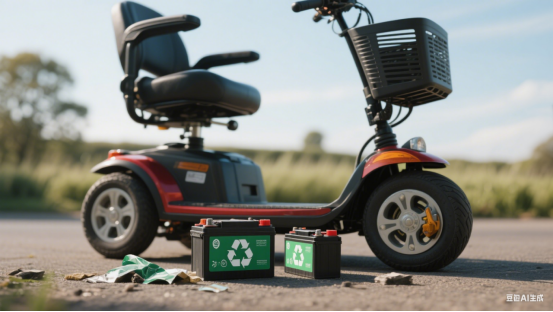
That dead mobility scooter battery taking up space in your garage isn’t just clutter—it’s hazardous waste. Tossing it in the trash isn’t just irresponsible; in most places, it’s illegal. But navigating battery disposal doesn’t have to be a headache. Whether you’re a scooter owner looking to get rid of an old lead-acid pack or a business importing lithium-ion batteries, understanding the rules keeps you safe, compliant, and kind to the planet. Let’s break down the do’s, don’ts, and everything in between.
First, let’s get one thing straight: never put a mobility scooter battery in your regular trash or recycling bin. Both lead-acid and lithium-ion batteries contain toxic or flammable materials that pose huge risks when mishandled. A lead-acid battery can leak corrosive sulfuric acid, while a lithium-ion battery might short-circuit and catch fire if crushed in a garbage truck. Instead, stick to three reliable disposal channels that work almost everywhere.
Retail take-back programs are the easiest option. Most auto parts stores (think AutoZone or Advance Auto Parts) and even some home improvement retailers accept lead-acid batteries for free—many are required by law to do so, thanks to “core charge” policies that incentivize recycling. For lithium-ion batteries, check with stores that partner with programs like Call2Recycle, which has drop-off bins in thousands of locations across North America.
If retail spots aren’t convenient, your local municipal recycling center’s household hazardous waste (HHW) facility will take both battery types. These sites are equipped to handle hazardous materials safely, so they’re ideal if you have multiple batteries to dispose of. For heavy-duty scooter batteries, specialized battery recyclers (like EcoBatt in Australia) are another solid choice—just call ahead to confirm they accept mobility scooter models.
You might be wondering: Is that “dead” battery really useless? Probably not. Lithium-ion batteries, in particular, often have life left in them. Most “failed” packs only have one or two faulty cells dragging down performance. A skilled technician can test the cells with a multimeter, replace the bad ones, and have your battery working again—at a fraction of the cost of a new pack.
Even if it’s truly at the end of its road, recycling turns waste into value. High-tech facilities extract cobalt, nickel, and lithium from old lithium-ion batteries, refining them for use in new batteries. This closed-loop system isn’t just eco-friendly—it’s a booming industry. Lead-acid batteries are also highly recyclable: up to 99% of their components can reuse, from lead plates to plastic casings.
For businesses, second-life applications are a smart way to cut costs and reduce waste. A scooter battery that can’t power a vehicle anymore often retains 70% of its charge—perfect for less demanding uses like solar street light storage, emergency backup systems, or warehouse tools. It’s a win-win: you avoid disposal fees, and you get extra mileage out of your investment.
The risks of cutting corners on disposal can’t be overstated. Improperly discarded batteries are a leading cause of fires in trash trucks and recycling facilities. Lithium-ion batteries are especially dangerous—they can ignite in a “thermal runaway” reaction if punctured or crushed, releasing toxic fumes. Lead-acid batteries leak lead, a neurotoxin that contaminates soil and groundwater, harming humans and wildlife alike.
Legally, the penalties are steep. Individuals might face fines of hundreds of dollars, while businesses could be hit with thousands in citations—plus reputational damage if a battery-related incident is traced back to them. For example, a restaurant that tossed an old scooter battery in a dumpster could be liable if it causes a fire at a waste facility. It’s simply not worth the risk.
If you’re importing or exporting mobility scooter batteries, compliance with international shipping laws is non-negotiable. The key? Partner with a supplier who understands the regulations. Look for UN-certified packaging, correct Class 9 hazardous goods labels, and essential documents like MSDS sheets and UN38.3 test reports (which prove the battery is safe for transport).
Lithium-ion batteries have extra rules: air freight requires them to less than 30%, and bulk shipments must follow treaties like the Basel Convention, which regulates cross-border hazardous waste movement. The EU’s new Battery Regulation adds even more steps, including “digital passports” for traceability. Always ask potential suppliers how they handle shipping compliance—vague answers are a red flag.
Disposing of mobility scooter batteries doesn’t complicated. For individuals, retail take-back programs and municipal HHW facilities are the go-to options. For businesses, repairing, repurposing, or recycling batteries saves money and reduces risk. Above all, remember: this isn’t just about following the law—it’s about keeping your community safe and protecting the environment.
Next time you have an old battery, skip the dumpster. Take five minutes to find a proper drop-off spot, or work with a trusted supplier for imports. It’s a small step that makes a big difference.
Copyright@ 2025 Nanjing Kangni Smart Technology Co., Ltd. All Right Reserved.